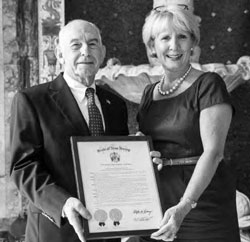Two University student teams ranked third and 19th in an online simulation business competition against approximately 350 competing teams from all over the nation.
This competition was based on Dr. Randy Chapman’s LINKS complex business simulations. Dr. David Paul, Associate Professor of Marketing and Health Care Management, uses these in his Services Marketing course every year. “This semester was the first time I heard of this ‘competition,’ because none of the teams ever placed high enough that I was informed of it,” said Paul
Benjamin Sutton, WilliamBrucella and Susan Imperiale placed 19th on the Key Performance Indicator of Ratio of Change in Net Income to Revenue, which shows the improvement of cash position over the prior quarter.
Brucella, a junior communication major with a business marketing minor, said he was shocked to find out about his team placing. “There really is no way of knowing how well we do compared to the other teams in the class unless the professor showed us our rankings,” he said.
Third place on the Key Performance Indicator of Forecasting Accuracy was given to the team of Robbie Krienke, Alex Whelan and Joseph Rienzi, which according to Paul this is “a pure signal of management skill and expertise in understanding customers and customer demand generation.” Paul continued to say, “their forecasting accuracy was 94.1 percent, which was 0.1 percent away from tying them for best in the world.”
Paul made certificates of achievement and presented them to the six students in class so the other students would be aware of the accomplishments.
These simulations are usually scenario-based and are used for development and learning. The students compete in a simulation of a service industry. Brucella said, “We just have to make decisions in order to gain more market shares, increase sales, and ultimately be the best firm in the industry.”
The manuals are often incredibly detailed and confusing. Paul advised his students to read the manual three times.
According to Paul, this is necessary because “the first time, it will make no sense whatsoever, and might as well have been written in Greek; a second time, more slowly than the first, and it will begin to not only make some sense but they will begin to see the logic; and a third time, and they will then begin to see that there are ‘hints’ embedded in the text as to how to do well in the simulation.”
Teams of three were formed in the class. “Each of which competed against all the others student teams to manage their firm in marketing a (non-specified) service,” said Paul. Following that “teams had to order and pay for marketing research in order to understand their markets.” They had to appeal to both businesses and consumers.
“Each team is responsible to make quarterly decisions from how much we pay our employees, how much our service will cost, and what kinds of market research we want to purchase for each quarter,” Brucella said.
Rienzi, senior business major with a concentration in marketing and management, said, “We had to look at marketing research and other data on a weekly basis regarding our services and other’s, then react to the research and change our stance in the market so our firm would hopefully be more successful than other firms.”
Each team’s work was submitted to Dr. Chapman’s website. “Each week constituted a quarter (i.e., 4 quarters/year), and decisions were submitted electronically by each team each quarter,” said Paul.
“In the 14 plus years I’ve been using marketing simulations, this is the first time one of my student teams has ever placed this high in either of these Key Performance Indicators,” Paul said regarding ranking.
Arizona State University, Penn State University, Clemson University, and Virginia Commonwealth University are just some of the other schools that participated and placed in this competition.


